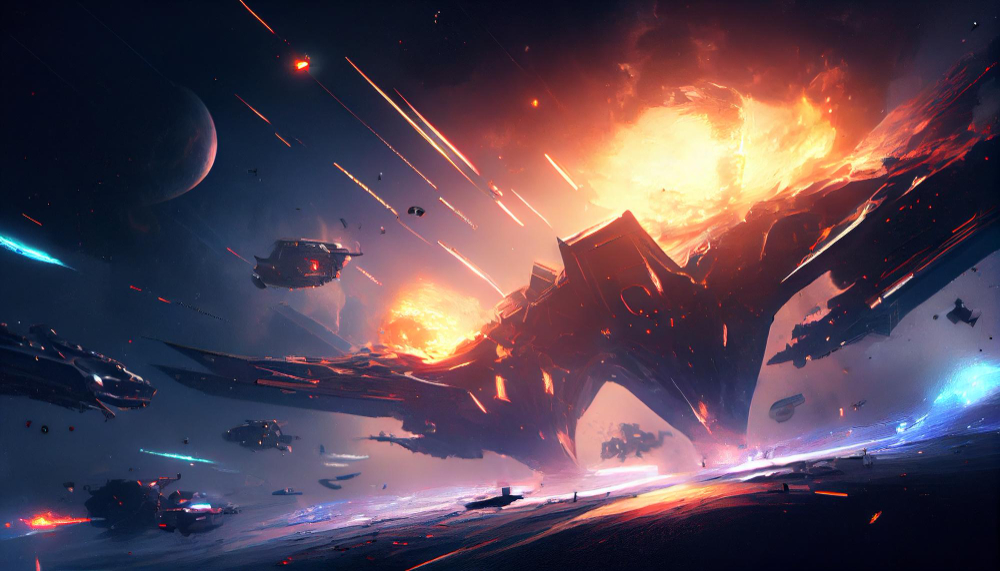Today in the world of gaming, Low poly assets play a decisive role in shaping the creative experiences that gamers aspire to. These assets, extending from characters and environments to objects and vehicles, are the platforms of virtual worlds. As technology advances, so does the complexity of these assets and one emerging force in the creation of 3D assets is generative AI.
In this blog post, we will discuss the significance of high poly and low poly assets in console gaming and understand the growing influence of generative AI in 3D asset creation.
1. Importance of 3D assets in gaming
3D assets, which are the creative and interactive models that breathe life into video games, serve as the digital sculptures meticulously crafted to transport players to fantastical realms, evoke emotions, and challenge their skills. Whether it’s the sleek, futuristic armor of a space marine or the lush, sprawling landscapes of a fantasy kingdom, these 3D assets are undeniably the heart and soul of gaming aesthetics. The environment of 3D asset creation is changing as a result of the introduction of generative AI. This advanced software can build 3D models with incredible precision and speed, bringing up new opportunities for game makers.
2. What Are High-Poly and Low-Poly 3d Assets?
High-poly and low-poly are the level of detail and complexity used to describe in 3D assets. High-poly assets include a large number of polygons, resulting in elaborate, detailed models. Low poly assets, on the other hand, use fewer polygons, simplifying and decreasing model complexity.
High-poly assets have a much larger polygon count, allowing for finer details and realism. Low-poly assets, on the other hand, forego some intricacy in exchange for improved performance. The decision between the two is determined by the game’s desired aesthetic and technological needs.
3. Importance of 3D Models in Gaming
3D models play an important part in the gaming industry as the visual designers of the overall experience. They bring people to life, create environments, and convey the core of a game’s plot. These models are more than simply eye pleasure; they form the foundation of player involvement and ultimate immersion.
Their impact goes beyond aesthetics, having a considerable impact on visual quality, gaming performance, and overall immersion. The visual appeal of a game is frequently linked to its success. With their rich features, lifelike textures, and motions, high-poly models add to amazing aesthetics. The sheer intricacy of high-poly models, on the other hand, might push gaming consoles to their limitations, potentially disrupting gameplay. Low-poly objects, on the other hand, while sacrificing some detail, ensure a smoother gameplay experience by assisting in maintaining the all-important target frame rates. This balance is essential for providing an immersive and entertaining gaming experience.

4. Console Gaming and Its Unique Challenges
The constraints and requirements of console gaming
Console gaming is a unique industry with distinct expectations and requirements that developers must carefully address. Consoles, in contrast to PCs, have fixed hardware configurations. This permanency needs challenging optimization work to ensure that games run smoothly on these predefined systems. Developers are constantly attempting to strike the exact balance between creating stunning visual fidelity and retaining maximum efficiency.
Factors like hardware limitations and frame rate targets
These difficulties are exaggerated by the limits of console technology, which include GPU capabilities, accessible RAM, and storage capacity. To make matters even more complicated, consoles often impose strict frame rate objectives, which are typically set at 30 or 60 frames per second (fps). Meeting these goals is critical as it ensures a continuous and intense gaming experience. However, in the worlds of mobile gaming and PC gaming, each comes with its unique set of challenges and requirements. This complexity makes the decision-making process for 3D low-poly assets a multidimensional affair.
5. High-Poly Assets in Console Gaming
When and why high-poly assets are preferred
High-poly assets find their moment to shine when realism and intricate detail take center stage. Games that aspire to provide cinematic experiences or showcase highly detailed characters and environments often favor high-poly assets. These assets excel at delivering a level of visual fidelity that can be utterly breathtaking, elevating the overall sense of immersion and storytelling within the game.
Benefits of high-poly models, such as realism and detail
The true beauty of high-poly models lies in the remarkable capacity to replicate real-world objects and characters with jaw-dropping precision. Additionally, every nuance, such as a character’s wrinkles, the texture of an object’s surface, or the subtle play of light and shadow, can be faithfully represented. Consequently, this attention to detail in gaming provides a more lifelike and emotional experience to the players. Titles like “The Last of Us Part II” and “Red Dead Redemption 2” stand as shining examples of games that harness the power of high-poly assets effectively on console platforms.
Examples of console games that utilize high-poly assets effectively
When it comes to console gaming, titles such as “Horizon Zero Dawn” and “God of War” stand as evidence to the remarkable powers of high-poly assets. These games boldly push the frontiers of visual fidelity, presenting players with environments that are both immersive and visually attractive, highlighting the potential and influence of high-poly assets in enriching the gaming experience.

6. Low-Poly Assets in Console Gaming
When and why low-poly game assets are preferred
When performance is non-negotiable, low-poly assets create out a niche in the gaming world. Games that live on fast-paced action, have huge open landscapes, or cater to multiplayer interactions often incorporate low-poly 3d assets to ensure a smooth, responsive, and creative game play experience. These materials strike a careful balance, delivering adequate aesthetic quality while prioritizing performance optimization.
Advantages of low-poly models
As resources are efficiently managed, the inherent advantages of low-poly models become more apparent. By using low poly assets, consoles can allocate more of their processing power to other key aspects of the gaming experience, such as handling complex physics simulations, advanced artificial intelligence, and elaborate gameplay dynamics. This optimization ensures that the game operates smoothly even under the most demanding in-game conditions, all while maintaining a level of visual quality that satisfies the expectations of the players.
Examples of console games that excel with low poly assets
Look no further than “Minecraft” and “Fortnite” to demonstrate the success of low poly assets in console gaming. Not only have these games embraced the usage of low-poly elements, but they have also made them into iconic visual styles. Their simplified designs not only improve speed, but also help to create distinct and recognized game worlds that players have grown to adore. These examples demonstrate low-poly assets’ exceptional adaptability and efficiency in the console gaming industry.
7. Striking the Right Balance Between High-Poly and Low-poly assets
The importance of finding the balance between high poly and low poly assets
Achieving the right balance between high poly and low poly assets is crucial for success in console game development. Creators must delicately consider factors like the game’s genre, aesthetic direction, and target audience to determine the assets that will enhance the overall gaming experience.
Strategies game developers use to optimize assets for consoles
To optimize assets for consoles, developers have a plethora of options at their disposal. One effective strategy is dynamically altering asset complexity using level of detail (LOD) systems based on the player’s vicinity. This approach ensures efficient resource utilization. Additionally, texture streaming approaches enable consoles to load textures only when needed, saving RAM. Efficient rendering pipelines play a crucial role in delivering stunning visuals and ensuring smooth performance in the game. These elements collectively enhance the immersive and entertaining gaming experience.
8. Generative AI and 3D Asset Creation
How generative AI is revolutionizing 3D asset creation
Generative AI represents a significant change in the 3D asset development creation. It allows developers to create 3D models at a startling pace and with exceptional precision by integrating machine learning techniques. This technical leap promises to profoundly change how game assets are created, lowering production costs and significantly shortening development times.and significantly shorter development times.
How to tailor AI-generated 3D models for console gaming.
The versatility of AI-generated 3D models is its beauty. Developers can fine-tune these assets to meet the unique needs of console gaming. This tailoring process extends to performance optimization, in which AI-generated models can be designed to work in harmony with console hardware limits. This allows developers to maintain high visual quality while maintaining smooth gameplay, making AI-generated materials a promising route for improving the console gaming experience.
9. Generating 3D Models from Photos
The concept of generating 3D models from images using AI
The concept of employing AI to generate 3D models from pictures opens up a world of possibilities. This new technology, also known as photogrammetry, uses the power of generative AI, used to replicate real-world objects and settings with astounding detail. It’s a stunning confluence of art and science, where a simple snapshot can serve as the template for creating elaborate 3D models.

Potential applications in console gaming
In the context of console gaming, the potential uses of producing 3D models from photos are nothing short of revolutionary. Consider the capacity to record real-world surroundings and effortlessly transform them into interactive gaming worlds. This technology has the potential to bridge the gap between reality and virtual gaming experiences, providing players with a level of immersion that was previously unimaginable. It has the ability to change how we see and interact with virtual worlds in the console gaming environment.
10. Online 3D Modeling Tools for Console Developers
Online 3D modeling tools that can help console game developers
The development of online 3D modeling tools suited to console developers has broadened the realm of game production. These tools are excellent resources, easing the often complex process of asset generation and optimization. They enable developers to create high-quality 3D objects with ease, thanks to easy interfaces, extensive asset libraries, and collaboration tools.
The accessibility and usefulness in the industry
These online 3D modeling tools have resulted in the democratization of asset development. They are now available to a diverse range of creators, from independent studios to industry behemoths, thereby leveling the playing field. As a result, these technologies streamline development workflows, lower production costs, and allow creators to focus on the creative parts of game design rather than technical complexity.
3daily, an online 3D modeling platform developed exclusively for the game industry, is one of the standout options in this area. This platform has a large and diversified library of pre-created 3D elements intended with gaming in mind. These easily available materials may be seamlessly integrated into console games, providing developers with a significant resource for saving both time and resources. Thereby, contributing to more efficient and cost-effective game production.
11. The Future: AI Generated and Pre Created 3D Assets for Consoles
Generative AI is advancing rapidly, ushering in exciting possibilities for the future of console gaming. AI-generated assets can transform content development, enabling developers to rapidly create vast, intricately detailed game worlds. This technology holds the potential to reshape the gaming industry.
However, in this dynamic landscape, AI-generated assets are attractive due to their speed and cost-effectiveness. They coexist with pre-created assets, which offer greater customizability and aesthetic control to developers. The choice between these two approaches depends on the unique demands and creative vision of each game, showcasing the industry’s adaptability.
Conclusion
In the dynamic world of console gaming, the choice between high poly and low poly assets is a crucial decision. It impacts visual quality, performance, and overall player experience. Finding the right balance between the two is essential for delivering captivating and responsive games. Looking ahead, the ongoing convergence of AI and 3D modeling promises to reshape the very essence of gaming. And in this exciting landscape, 3daily emerges as a Generative AI Technology, offering a diverse array of pre-created 3D assets in both low-poly and high-poly formats, catering to the diverse needs of the gaming industry.



